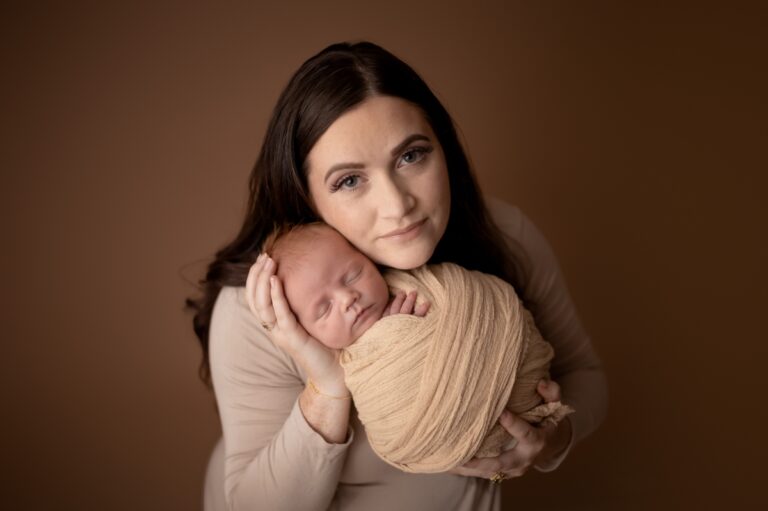When government gets between a mother and a midwife

This article first appeared in the winter 2023 edition of Sword&Scales.
The birth of a child is a sacred experience in a mother’s life. How and where she chooses to bring her baby into the world is a deeply personal decision that should be free from government interference.
Yet in some states, certificate-of-need (CON) laws stand between mothers and their freedom to choose where they give birth.
A birth center in Georgia
Katie Chubb and her husband Nick drove nearly three hours from Augusta, Georgia, to deliver their baby at the Atlanta Birth Center. Taking a road trip is the last thing a mother in labor wants to do. But Katie had her mind set on having her baby in a birth center, and there weren’t any options closer to home.
Katie is from the United Kingdom, where midwifery is a common practice. When she was pregnant for the first time, she and Nick weighed whether to go with a midwife or an obstetrician. They met with an OB at their local hospital, but the appointment left them disappointed.
“They separated Nick and I into different rooms,” Katie remembers. “They told me information I already knew.”
The Atlanta Birth Center, on the other hand, blew Katie away. “It was like no other care I had ever received,” she remembers.
When I went to the birth center, they’re like, “Okay, what do you know about your pregnancy? How educated are you? What do you want to know going forward? What can we help you with? What resources can we connect you with?” It was completely different.
Nick was also impressed. “I thought, ‘This is significantly better for the family. Not just for the mother, but for the family,’” he said.
How the government standardizes childbirth
Today, 99 percent of American women give birth in a hospital, according to Lauren Hall’s The Medicalization of Birth and Death.
Hall writes:
Almost 40 percent of those women will be induced, over one-third will have a cesarean section, and many more will have forceps deliveries, episiotomies, labor augmentation, or other interventions. These intervention rates are much higher than those in comparable developed countries. Despite the high rates of interventions, and in part because of them, maternal mortality has actually risen in the past decade[.]
Birth wasn’t always like this in America. But starting in the 1910s and ’20s, state governments began to pass regulations aimed at standardizing medical care. Then, in 1946, President Harry Truman passed the Hill-Burton Act, which injected federal money into hospital systems.
“And in order to do that, they actually create these blueprints of what these hospitals should look like,” Hall says. “And those blueprints end up really calcifying maternity care… As the hospitals get standardized, patients get standardized, too.”
Delivery wards became almost like factories designed to treat expectant mothers as quickly and efficiently as possible. When doctors see dozens of patients each day in a hospital, they’re often forced to resort to a “one size fits all” model that uses medical intervention for everybody. That’s not a problem for the majority of women. But some are desperate for a less “factory”-like experience.
Midwives, on the other hand, tend to be more personal and flexible: They’re more likely to follow mothers’ lead and less likely to insist on medical interventions unless necessary. They’re also more likely to have a continued relationship with families post-partum. That’s what a lot of women want.
As Nick puts it, “A doctor will say, ‘I’m delivering this baby.’ The midwifery way is to say: ‘You are going to be having this baby.’ The midwife is there to make sure you are okay and to assist in the process.”
Midwives in Iowa
Caitlin Hainley her first child in China when she and her husband were living abroad. She labored for a long time, then had an emergency C-section. When she got pregnant again, she wanted the option of having a vaginal birth, which many doctors will not allow if a mother has previously had a C-section.
Her family moved back to the United States late in her pregnancy, thinking they would have more birthing options. In a shocking turn of events, Caitlin learned that she would have had more choices had she stayed in China. The American hospital she went to insisted that she have another C-section.
Caitlin decided to use a midwife instead. Caitlin recalls how the midwives’ faith in her ability to deliver without needing major surgery made her feel supported. She had the freedom to choose what was best for her and her baby. She gave birth to a healthy baby without needing a C-section.
Caitlin eventually went to school to get her nursing degree, then became a midwife. She and her husband struggled financially during her pregnancies, and most midwives don’t take insurance, which made things hard for Caitlin’s family. She wanted things to be better for women in her home state, Iowa. So she and another midwife, Emily Zambrano-Andrews, started the Des Moines Midwife Collective, the first homebirth service to accept insurance.
Both women love what they do and consider it a great privilege to assist and support expectant mothers. Their midwife service gives mothers the freedom to choose how they want to give birth while significantly lessening the financial burden.
The only problem is that legally, Caitlin and Emily can’t have an office. They only can visit patients in their homes. Emily and Caitlin dreamed of opening a freestanding birth center where mothers could come to deliver their babies.
But Iowa’s certificate-of-need laws have prevented them from opening their birth center.
Certificate-of-need laws
Certificate-of-need laws are a state-level problem—but like a lot of state problems, they started with the federal government.
In 1974, Congress passed the National Health Planning and Resources Development Act, which created financial incentives for states to develop new regulatory processes for health-related services— including CON laws.
CON laws force new businesses to prove there’s a community need for their services. In states with these laws, competing businesses—in this case, hospitals—are given an opportunity to quash a new service’s application for a certificate of need.
These laws do not help patients. A 2016 Mercatus Center study found that hospitals in CON states perform worse than those in non-CON states. Even the Federal Trade Commission and the Department of Justice have argued for the repeal of CON laws, noting that while the laws had “laudable goals… it is now apparent that CON laws can prevent the efficient functioning of health care markets[.]”
Iowa is a CON law state. Iowa allows midwives to assist in homebirths without issue. But if a midwife wants to open a freestanding birth center offering those same services, they must apply for a certificate of need—and before their certificate is approved, competitors will have a chance to argue in a hearing that there’s no need for new birth services.
In Iowa history, there have been only two birth centers that were able to get certificates of need, both of which are now closed.
Here’s where the Iowa laws get really strange.
After one of the former birth centers closed, the owner kept the building and now uses it as a “birth bnb” where midwives and laboring mothers can come to deliver babies. As long as midwives bring their own supplies and equipment, no certificate of need is needed. The CON laws come into play only if supplies and equipment are kept on the premises. In other words, Iowa is incentivizing makeshift arrangements like “birth bnbs” over permanent birth centers where equipment is kept on site.
Caitlin and Emily now are challenging Iowa’s certificate-of-need law in court, with PLF’s help.
Starting a new Georgia birth center
In Georgia, Katie Chubb also is working with PLF to fight certificate-of-need laws.
After her experience with the Atlanta Birth Center, she went home to Augusta and began to wonder: “How hard would it be to start a birth center here?”
Nick loved the idea and was fully onboard. He saw childbirth as a family affair, not something a woman should have to do on her own. What he and Katie envisioned wouldn’t just be a place to give birth—it would be a community of families who were there to support and learn from each other. The Augusta Birth Center would offer a variety of workshops, including classes on CPR, “Daddy Doula” classes, and even a workshop on introducing new babies to family dogs.
Nearly everyone Katie and Nick told about their birth center supported their idea whole-heartedly… except existing hospitals. To get a certificate of need, Katie and Nick needed one of the local hospitals to sign a transfer agreement, stating that the hospital would admit birth center patients in an emergency. But none of the hospitals would sign.
Hospitals are businesses with a near-monopoly on birth. They have every reason to veto competition.
Katie knows there’s a need in Augusta for a birth center. There is currently no birth center within a 130-mile radius, and only one of three local hospitals offers midwifery services. Local nurses have told Katie stories about hospitals not having enough beds and women giving birth in hospital hallways. Georgia has the second-highest maternal mortality rate in the country. In some years, the Augusta-area maternal mortality rate ranks higher than in Cuba or Syria.
These problems aren’t exclusive to Georgia. According to a recent report by the Commonwealth Fund, the United States has the highest infant and maternal mortality rates out of all developed countries—and this is despite spending the most on health care.
The government’s stranglehold on midwifery practices is not helping.
Getting government out of the way
Caitlin has five children. Her last two kids she had at home. That’s what most women who don’t want to give birth in a hospital end up doing. But women shouldn’t be forced to choose between a hospital or home.
“I don’t ever want people to feel like they have to have their baby alone because they don’t have access to the type of care they desire,” Caitlin says.
Women have traditionally given birth surrounded by other women—by a support system, including midwives and doulas, who stay with them through the process. That’s what Caitlin and Emily want to provide in Iowa and what Katie Chubb wants to provide in Georgia.
The government should get out of these women’s way.
By preventing midwives from opening birth centers, CON laws are restricting one of the most important and personal choices a woman can make: how to give birth to her child. It’s the very first choice a mother makes in an endless series of parenting choices she’ll make as her child grows older, learns to walk, goes to school, and becomes an adult in the world. This first choice—how to bring her child into the world, whom to trust with her child’s delivery, where she should be when her child takes a first breath and looks around— cannot be redone. It’s a private and personal decision that is not the government’s to make.
Caitlin, Emily, and Katie want to give women more choices for childbirth. CON laws give them fewer. It’s that simple. Some women feel safer and more comfortable when they are working with midwives in a birth center—and they should have the freedom to make that choice for themselves and their families.
Pacific Legal Foundation is representing both Katie’s Augusta Birth Center and Emily and Caitlin’s Des Moines Midwife Collective to fight back against CON laws and protect each mother’s right to give birth as she chooses.






